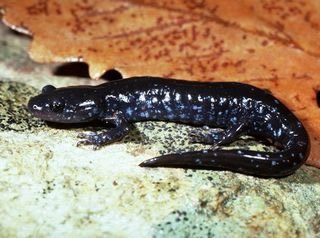- Blue-spotted Salamander
Taxobox
name = Blue-spotted Salamander
status = LC | status_system = IUCN3.1
trend = stable

image_width = 240px
regnum =Animal ia
divisio = Chordata
classis =Lissamphibia
ordo =Caudata
familia =Ambystomatidae
genus = "Ambystoma "
species = "A. laterale"
binomial = "Ambystoma laterale"
binomial_authority = Hallowell,1856 The Blue-spotted salamander, or "Ambystoma laterale", is amole salamander native to theGreat Lakes states and northeasternUnited States , and parts ofOntario andQuebec inCanada . Their range is known to extend toJames Bay to the north, and southeasternManitoba to the west.Description
These salamanders are between 8 and 14 cm in length, of which the tail comprises 40%. Their skin is bluish-black, with characteristic blue and white flecks on its back, and bluish-white spots on the sides of its body and tail. They have an elongated body, though they are not nearly as slender as the
Jefferson Salamander . The vent is typically black, which contrasts with the paler belly. Larvae which have transformed may have yellow splotches; these turn blue once the individual becomes terrestrial. Occasionally, a melanistic individual may be found in the wild.They have long toes: four on the front feet, and five on the hind feet. Typically, specimens will have 12-14 costal grooves. Males tend to be smaller than females, though they have longer, flattened tails.
Habitat
The Blue-spotted Salamander are primarily found in moist,
deciduous hardwoodforest s and swampywoodland s, though they can be found in coniferous forests and fields too. They prefer vernal ponds that retain water into mid-summer, to ensure access to a suitable breeding habitat. Underbrush, leaf litter, rocks and logs are commonly used for shelter.Reproduction
Eggs are laid in small agglomerations attached to twigs, rocks or plants at the edge of a woodland pond or ditch. Clutches average a dozen eggs, and females may lay up to 500 eggs yearly. Males and females first mate when two years old. Breeding occurs in early spring near ephemeral ponds.
Eggs take about one month to hatch. At hatching, larvae have a well-developed mouth and eyes. Front limbs form at two weeks, and hind limbs form at three weeks. It will fully transform to its terrestrial state by late summer.
This species is also known to hybridize with other salamanders, especially the
Jefferson Salamander ,Spotted Salamander andTiger Salamander . The hybrid of Blue-spotted salamanders and Jefferson salamanders has the binomial taxon "Ambystoma platineum". Hybrid offspring are clonal triploid females, which reproduce .References
* Database entry includes a range map and a brief justification of why this species is of least concern.
* [http://www.iucnredlist.org/search/rangemap.php?species=59060 IUCN Range
]
* [http://ebeltz.net/herps/etymain.html#Salamanders Scientific and Common Names of the Reptiles and Amphibians of North America Explained]
Wikimedia Foundation. 2010.
